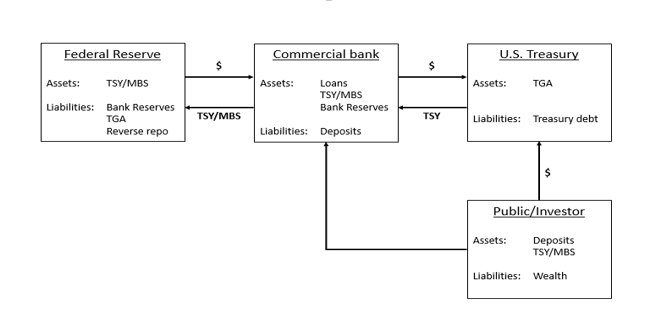Written by: Jordan Jackson
Markets will likely spend the balance of the year intensely focused on tapering. Importantly though, investors should recognize that tapering is not a tightening in monetary policy, but rather a shift towards less accommodative policy. Since March 2020, the Federal Reserve’s (Fed) balance sheet has grown by $4.02trn1 and, assuming tapering begins in December of this year and lasts through mid-2022, the balance sheet could rise by another ~$800bn2, further increasing liquidity in the system. As tapering moves to the forefront of policy discussions, investors should understand the mechanics of quantitative easing (QE), how money is created and flows into the financial system, and the impact it’s having on financial markets.
As the flow chart details, when the Fed engages in QE, the transaction involves electronically creating “money” and using it to purchase securities, primarily U.S. Treasuries and mortgage-backed securities (MBS), from banks and broker dealers, allowing the balance sheet to grow in size. The transaction credits the financial institutions’ reserve account at the Fed—and voila—cash has officially entered into the financial system.
At that point, the bank has to decide what to do with this new cash. They can either buy another asset/security, in which case the cash moves from one banking entity to another; lend it out to credible borrowers, which is subject to loan demand; or hold it in the form of excess reserves at the Fed and receive the interest rate paid on excess reserves (IOER)3. Unless the cash is lent out, QE dollars will typically remain in the banking system.
In the upcoming article, we’ll discuss where this money has flowed to in the financial system given the current regulatory environment and the impact it’s having on interest rates.

Source: J.P. Morgan Asset Management
Related: Where Are Millennials Investing Their Money?
1Balance sheet growth from March 11, 2020 to August 26, 2021.
2Assumes continued pace of $120bn in asset purchases through November 2021. Thereafter, purchases will be reduced by $15bn per month, beginning in December 2021 and concluding by July 2022.
3As of August 31, 2021, the Interest paid on excess reserves is 0.15%.


